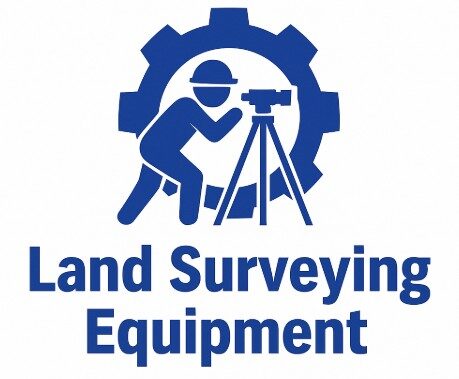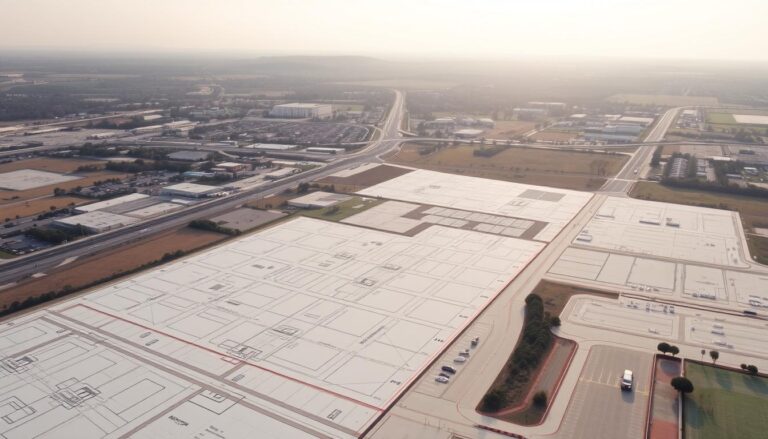Land Surveying Glossary: 80 Terms Every Pro Should Know
This glossary breaks down essential surveying terms into four key sections: core terminology, instruments and tools, types of surveys, and calculations/legal concepts. Whether you’re new to surveying or a seasoned pro, this guide covers the language every professional should know.

Section 1: Core Surveying Terms
1 – Benchmark – A fixed reference point of known elevation.
2 – Datum – A base reference surface or point for measurements.
3 – Traverse – A connected series of lines with known lengths and angles.
4 – Bearing – A directional angle between two points relative to a reference meridian.
5 – Azimuth – A compass angle measured clockwise from north.
6 – Meridian – A reference north-south line used for direction.
7 – Plumb Bob – A pointed weight used to find true vertical.
8 – Station – A specific point where measurements are taken.
9 – Foresight – A reading taken on a forward point to determine elevation.
10 – Backsight – A reading taken on a known point to establish instrument height.
11 – Turning Point – A temporary point used to transfer elevations.
12 – Leveling – The process of determining the height difference between points.
13 – Control Point – A reference location with known coordinates.
14 – Hub – A marker, often a wooden or metal stake, used to denote survey points.
15 – Taping – Measuring distances using a surveyor’s tape.
16 – Offset – A perpendicular measurement from a baseline.
17 – Traverse Adjustment – Correcting measurements to close a traverse loop.
18 – Closure Error – The discrepancy in a closed loop of a survey.
19 – Chainage – Distance measured along a survey line.
20 – Stakeout – Marking the ground with physical reference points from plans.
Section 2: Instruments and Equipment
1 – Total Station – A device that measures distances and angles electronically.
2 – Theodolite – A precision instrument for measuring angles in two planes.
3 – GPS Receiver – A satellite-based device to determine exact location.
4 – GNSS – A global satellite system including GPS, GLONASS, Galileo, and others.
5 – Level – An optical instrument to establish horizontal lines of sight.
6 – Tripod – A stable three-legged stand for mounting survey instruments.
7 – Laser Scanner – A tool for collecting detailed 3D spatial data.
8 – LIDAR – A remote sensing tool using lasers for precise terrain mapping.
9 – Drone – An unmanned aerial system used for survey and mapping.
10 – Prism Pole – A pole with a reflective target used with a total station.
11 – Level Rod – A graduated rod used to determine elevation changes.
12 – Range Pole – A pole used to mark or target survey points.
13 – Data Collector – A handheld computer that logs field measurements.
14 – Optical Square – A small tool used for creating 90-degree angles.
15 – Planimeter – A tool used to measure the area of shapes on paper.
16 – Measuring Wheel – A wheel device rolled to measure distances.
17 – Tribrach – A base with leveling screws for precise instrument setup.
18 – Clamp – A fastener to hold equipment in a fixed position.
19 – Battery Pack – A portable power source for electronic tools.
20 – Instrument Case – A hard container for protecting survey equipment.
Section 3: Types of Surveys and Methods
1 – Topographic Survey – Captures terrain elevations and physical features.
2 – Boundary Survey – Establishes the legal boundaries of land.
3 – Construction Survey – Marks out locations for building structures.
4 – Control Survey – Sets reference points to guide other surveys.
5 – Geodetic Survey – Large-scale survey accounting for Earth’s curvature.
6 – Cadastral Survey – Defines land ownership and boundary records.
7 – As-Built Survey – Verifies construction matches plans after completion.
8 – Hydrographic Survey – Measures underwater features and depth.
9 – Aerial Survey – Uses aircraft or drones to collect survey data.
10 – Right-of-Way Survey – Identifies land used for infrastructure projects.
11 – Route Survey – Surveys corridors for roads, pipelines, and utilities.
12 – Mining Survey – Supports layout and operation of mining areas.
13 – Photogrammetric Survey – Uses images to extract accurate spatial data.
14 – Subdivision Survey – Divides land into plots for development.
15 – Volumetric Survey – Calculates volumes of earthworks or stockpiles.
16 – Deformation Survey – Monitors structural or terrain movement.
17 – Utility Survey – Maps underground or aboveground utility locations.
18 – Engineering Survey – Supports construction and infrastructure design.
19 – Environmental Survey – Assesses features for ecological impact or planning.
20 – Property Survey – Documents the features and limits of a land parcel.
Section 4: Measurements, Calculations, and Legal Terms
1 – Elevation – The height of a point above a reference level.
2 – Contour Line – Connects points of equal elevation on a map.
3 – Grade – The slope or incline expressed as a percentage.
4 – Vertical Angle – The angle measured above or below the horizontal.
5 – Horizontal Distance – The straight-line distance between two points.
6 – Linear Measurement – The act of measuring straight distances.
7 – Coordinate – A set of numbers identifying a point’s position.
8 – Area Calculation – The process of determining land surface area.
9 – Volume Calculation – Used in earthworks to measure material amounts.
10 – Cut and Fill – Earth moved to level a site for construction.
11 – Error Adjustment – Correcting measurements to improve accuracy.
12 – Legal Description – The written record defining property boundaries.
13 – Encroachment – When one structure crosses into another property.
14 – Right of Way – A legal right to pass through land owned by another.
15 – Easement – The right to use land for a specific purpose without owning it.
16 – Plat – A detailed map showing lots, streets, and legal divisions.
17 – Monument – A physical object that marks a boundary or survey point.
18 – Title Block – The information panel on survey drawings or plans.
19 – GIS – A system that manages spatial data for mapping and analysis.
20 – Datum Shift – A change in coordinate reference systems affecting positioning.






